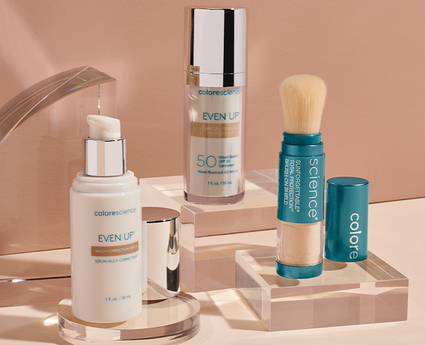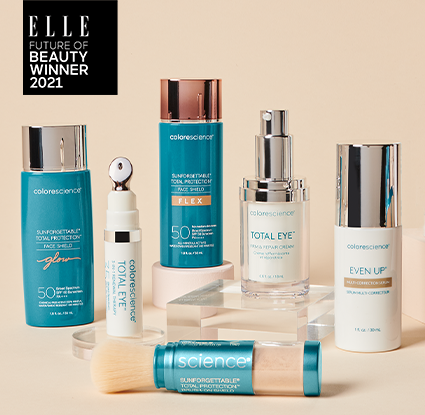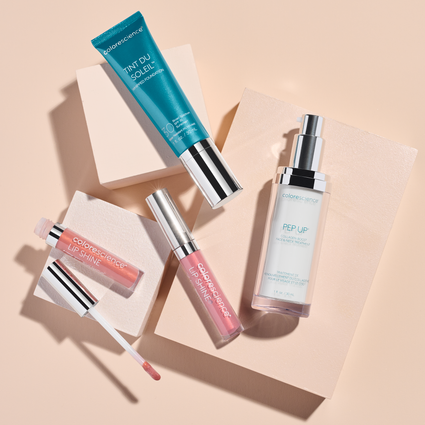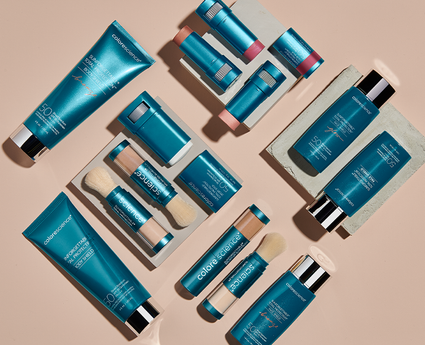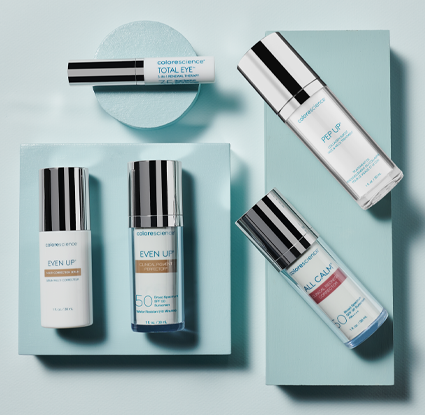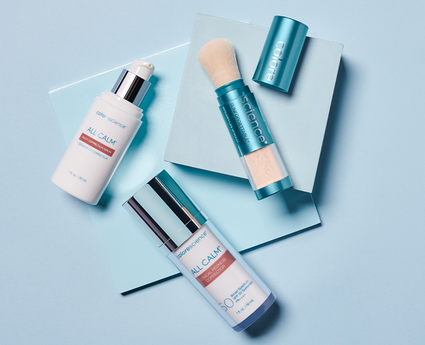Blue Light Effect on Skin: Does Blue Light Damage Skin?
Blue Light Effect on Skin: Does Blue Light Damage Skin?
You might have heard that blue light is bad for your eyes, but did you know that it’s bad for your skin, too? Few people are aware of the damage they might incur by spending time in front of their devices, leading to premature signs of aging. Translation: loss of firmness, fine lines, wrinkles, dark spots, and hyperpigmentation.
Today’s post will cover all you need to know about blue light’s effect on skin, including ways you can protect your youthful complexion against this environmental stressor. Click on a link below to jump directly to the information you’re looking for, or read end-to-end and ensure your best asset is fully protected from every angle.
- What is Blue Light?
- Where Does Blue Light Come From?
- Is Blue Light Bad for Your Skin?
- How Does Blue Light Damage Skin?
- How to Protect Your Skin from Blue Light
- Key Takeaways
What is Blue Light?
Blue light, also known as high-energy visible (HEV) light, is both natural and man-made, appearing in shades that range from blue/turquoise to blue/violet. Unlike the sun’s ultraviolet (UV) rays that we can’t see but can certainly feel, HEV is the opposite; you can see blue light, but you can’t feel its heat.
All light is made up of electromagnetic particles that travel in waves, and each color of the rainbow — red, orange, yellow, green, blue, indigo, violet, or ROYGBIV — occurs at a different wavelength, measured in nanometers (nm).
Red light has the longest wavelength with the weakest energy, and the intensity increases across the ROYGBIV light spectrum. Blue, indigo, and violet are the strongest, hence the name “high-energy visible light”.

With a wavelength between approximately 390 and 500 nm, blue light can penetrate skin more deeply than both UVA and UVB rays, extending past the epidermis deep within the dermal layer of tissue.
Where Does Blue Light Come From?
The largest source of blue light is the sun; HEV blue light rays account for 50% of all solar radiation and are actually what makes the sky look blue, which makes every day sunscreen usage an important part of your skincare routine. However, most people associate it with light emitting diodes (LEDs) used in digital devices, such as your:
- Smartphone
- Computer
- Tablet
- Television
These are just a few examples of electronics that use LED backlight technology to enhance the screen’s brightness and clarity, but lamps containing LED and fluorescent bulbs are also a major source of blue light. These waves are nearly everywhere in our surroundings — both indoors and outdoors — and most of the time, we barely even notice.

Some studies suggest that 60% of people spend more than six hours per day in front of a digital device. Between jobs that require computer usage at work, watching TV at home, scrolling through your phone on-the-go, and spending time outdoors, it can seem nearly impossible to escape all the blue light in your environment.
Is Blue Light Bad for Your Skin?
Yes, recent studies have proven that exposure to blue light can have adverse biological effects on skin in as little as one hour. According to dermatologist Dr. Murad, if you were to spend four eight-hour workdays in front of a computer, you’d be exposed to the same amount of energy as 20 minutes in the midday sun.
This may seem inconsequential, but Dr. Murad notes that just seven minutes of unprotected sun exposure at 1:00 PM can give you an immediate tan. If you combine the repeated exposure at work with the daily exposure from the sun, digital devices, LEDs, and fluorescent lights, the accumulative blue light effect on skin can be very substantial.
Not all blue light is bad. The HEV wavelength has an antimicrobial effect and is often used as an FDA-approved acne treatment due to its scientifically proven ability to kill the P. acnes bacteria known to cause breakouts.
However, studies reveal that longer exposure to high-energy blue light can increase the amount of DNA damage, cell and tissue death, skin barrier functioning, and photoaging. Blue light harm is not exclusive to skin; its impairment on the circadian system and eye physiology are also well-documented.

How Does Blue Light Damage Skin?
Now you know that frequent screen time does your complexion a disfavor, but you might be curious as to how exactly blue light damages skin. The answer is due to oxidative stress — the imbalance between free radicals and antioxidants — upon irradiation with visible light. Here’s how it works:
- Exposure to blue light increases the generation of reactive oxygen species (ROS), including free radicals.
- Free radicals are molecules with unpaired electrons; most are unstable and highly reactive. They rob other cells of electrons, resulting in oxidative stress.
- Blue light wavelengths penetrate skin and stimulate the production of free radicals that attack the DNA tissue of healthy cells.
- Blue light energy extends into the dermal layer of skin tissue, where it encounters collagen and elastin — the two proteins responsible for giving skin its strength and flexibility.
- When collagen and elastin weaken due to free radical damage, the signs of aging accelerate (also known as photoaging) because skin loses its plump, voluminous integrity and becomes more prone to the development of fine lines and wrinkles.
- Blue light also induces hyperpigmentation that can lead to sunspots or dark spots by affects the production of melanin in your skin cells — the dark pigment responsible for tanning your skin in response to sunlight exposure. Researchers found that pigmentation caused by HEV light is darker and more sustained than that caused by either UVA or UVB exposure.
- Although blue light therapy can be used to treat the inflammation associated with bacterial acne, the ROS created by excess blue light triggers inflammation, redness, and swelling. This also impairs the functionality of the skin cell barrier, leading to loss of moisture retention and weakened immunity.
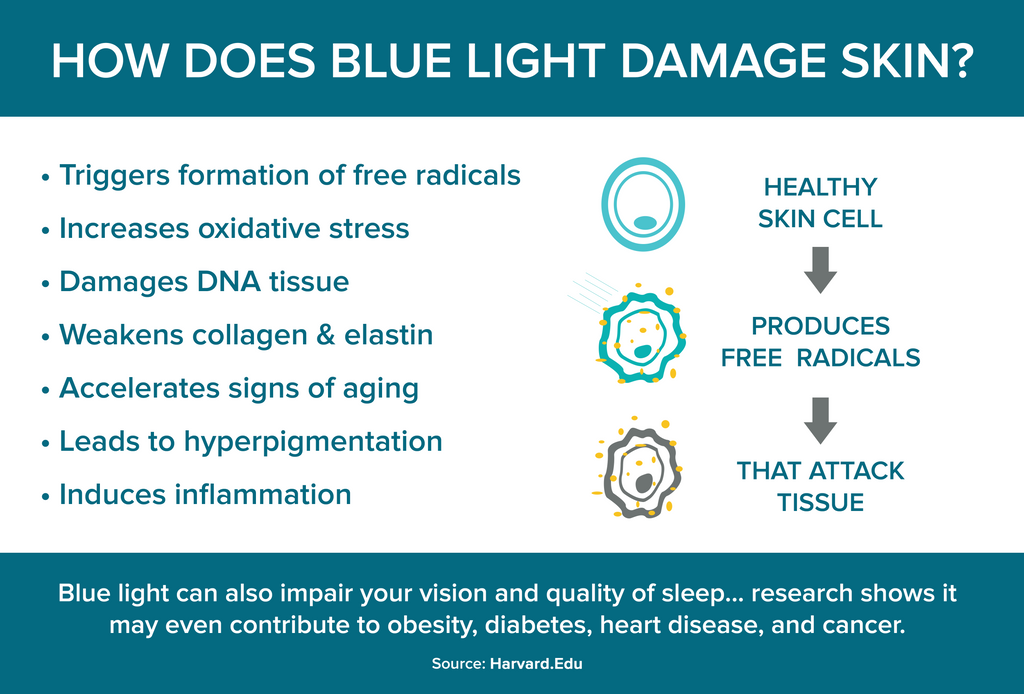
Skin is very vulnerable to oxidative stress, and the blue light effect on skin slowly compounds overtime. By causing additional eye strain, it can lead to the development of more pronounced wrinkles near the eyes and between the brows that can be treated with skin firming eye creams. If it disrupts your circadian rhythm, lack of sleep can appear as dark circles or puffy eyebags. Harvard.Edu explains that blue light damage is more than just aesthetics, as research suggests it may also contribute to obesity, heart disease, and cancer.
How to Protect Your Skin from Blue Light Damage
When it comes to protecting your skin from blue light damage, research indicates that additional measures beyond UV filters are required; minerals like titanium dioxide and iron oxide are considered the gold standard for blue light protection due to their ability to scatter the visible light spectrum.
Some scientists say that full protection against UV radiation (UVR) and visible light irradiation is only achieved when combined with antioxidants — your body’s natural form of defense against oxidative stress induced by free radicals. They can safely interact with these molecules and terminate their chain reaction before DNA damage occurs. You can consume antioxidants in your diet, but they can also be applied topically.
Another study found that niacinamide (vitamin B3) has the potential to protect against blue light induced hyperpigmentation, helping to preserve a smooth, even complexion.
There are a number of niacinamide skin care products that offer these benefits for your skin. At Colorescience, we offer formulas packed with vitamins, minerals, and antioxidants to help you combat all the stressors your skin might encounter inside or outside throughout your day-to-day life including UV rays, blue light, infrared radiation, and particles found in polluted air.

Our Sunforgettable® Total Protection™ harnesses the all-natural power of specialty ingredients such as:
- Zinc oxide and titanium dioxide - Gentle and safe minerals in sunscreen provide safe and effective broad-spectrum coverage for both UVA and UVB rays
- Iron oxides - Micronized pigments that protect skin from photoaging caused by blue light
- InfraGard - A combination of organic sunflower sprouts and the antioxidant known as tara tannins designed to protect against photoaging effects caused by IR
- Vitachelox® - A potent blend of three antioxidants (green tea, grape seed, and oak wood extracts) to shield against free radicals and pollution
Using only the highest quality ingredients found in nature, we offer safe sunscreen and skincare products for sensitive skin that will never trigger irritation due to chemical reaction. You can choose between different formulas — including powder, liquid, and sport stick — and add our SPF foundation for sensitive skin for even greater protection.
Key Takeaways
Is blue light bad for skin? Yes, but it doesn’t mean you have to unplug all your devices for good. Maintain defense against daily stressors with Colorescience Total Protection Sunscreen and stay up-to-date with facts about sun damage and your skin to preserve your complexion’s youthful vitality.

